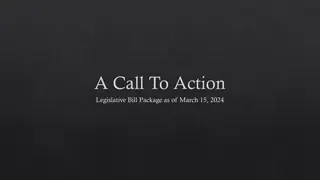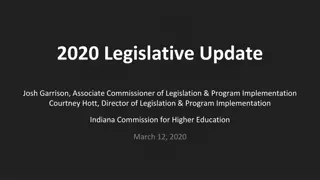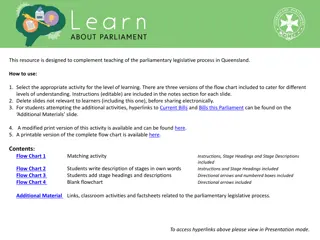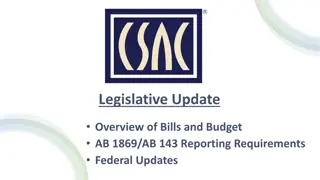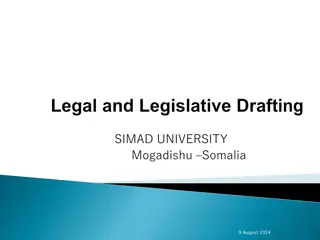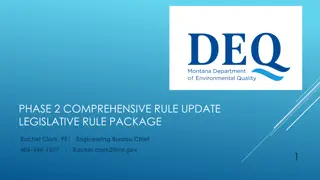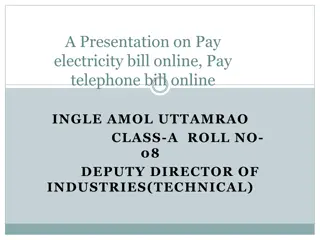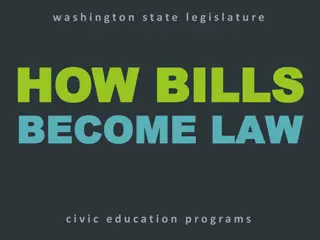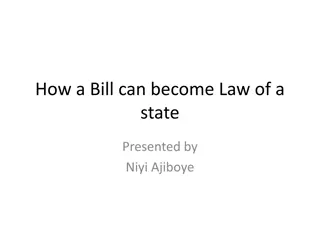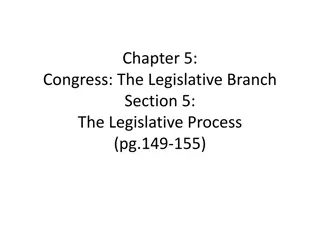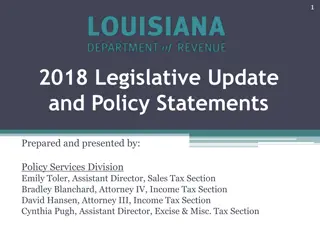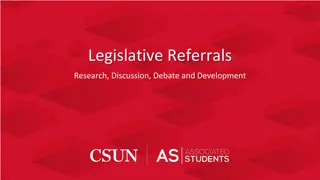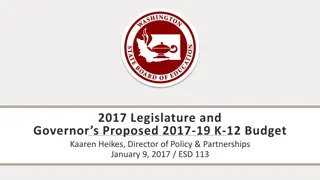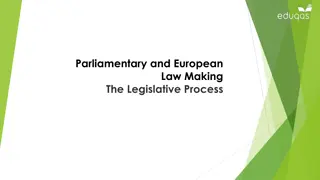Understanding the Development and Legislative Process of Committee Bills
Learn about the vital steps involved in developing committee bills, starting from outlining the policy goals to implementing the final legislation. Discover the time frame required for the development process based on a sample of 22 bills and the key elements that contribute to the efficiency of drafting legislation.
Download Presentation

Please find below an Image/Link to download the presentation.
The content on the website is provided AS IS for your information and personal use only. It may not be sold, licensed, or shared on other websites without obtaining consent from the author. Download presentation by click this link. If you encounter any issues during the download, it is possible that the publisher has removed the file from their server.
E N D
Presentation Transcript
Committee Bill Committee Bill Development and Legislative Process Development and Legislative Process 1
CLSO Standard operating procedure CLSO Standard operating procedure briefing a drafter to develop legislation briefing a drafter to develop legislation A policy outlines what the committee hopes to achieve - the goal. It further sets out the principles that applies to the solution, and the methods that will be used to achieve the goal and give effect to the principles. A policy document is not a law but it will often identify new laws needed to achieve its goals. (etu.org.za) To develop legislation, a drafter needs a policy that informs the desired legislation A policy is normally done by a researcher or specialist in the subject (in Parliament Committee s researcher and content adviser). Subject matter experts can be a departmental official, a researcher, an academic, or an industry expert. A policy document must: Identify the mischief / gap in the law / the problem that concerns the committee; Show the research done and possible solutions e.g. what the best practice is in other countries, or in similar fields, to address the problem; Explain solutions, including non legislative solutions, considered and highlight the research done on these possible solutions; Indicate which is the most suitable solution; and Explain how the solution will be implemented (what is needed: Who is responsible to execute? What must they do to fix the problem? What resources are need? What is the time frame for implementation? Will it all be implemented at once, or in phases? Are there operational details that need to be done in regulations? How will implementation be monitored? Reporting to Parliament? etc.). 2
Time needed to develop a Committee Bill Time needed to develop a Committee Bill From a sample of 22 Bills: 16 (72%) Bills were developed within a year from permission (2 were very urgent; 10 (62% of the 16 Bills) were Bills submitted by the Executive); 2 (9%) took between 1 and 2 years from permission to be developed 3 (13%) took 2 years from permission to be developed 1 (4%) took 5 years from permission to be developed (FMPA New Act to be administered by Parliament) Notes: These stats are not fully comparing the same circumstances: Some Bills are completed drafts provided by the Executive or only adding a read in provided by the Constitutional Court. Others review an Act, or is contentious, and may thus take disproportionately longer. The date of permission used in these stats is also not necessarily the same as the date when the process commenced Generally it can be said that a Committee Bill takes between one and two years to develop. Bills which focus on 1 or 2 topics, where the policy is fully developed, can be completed within a year. Where the policy direction is not clear at the outset, the development of a Bill takes much longer: Work on the National Credit Amendment Bill started in June 2016 in the Portfolio Committee. Permission to develop a Bill was given in March 2017 and the Bill was introduced in September 2018. = 2 years and 4 months to develop A shorter time frame requires a clear policy direction, and more resources over a spectrum of skills, working together as a dedicated team. 3
Legislative Process NAR 273 to 275 Committee adopts and tables a memorandum setting out the particulars and objects of the proposed Bill; whether it has financial implications; and the views of the Executive on the proposed Bill. The Committee must thus develop a policy that will inform the Bill, before permission can be sought. Sources to develop a policy: Department; Constitutional Court read in; Content Adviser / Researcher develop a policy in accordance with Committee discussions. Once the Assembly has approved the memorandum, the Committee develops a Bill. Legal Services has the capacity to assist a Committee in this regard. Draft 1 Consult JTM on classification (and NHTKL if applicable); Report on the Bill to the House; Advertise intention to introduce and call for comments (public involvement) Interested persons must be given at least three weeks after publication to comment. Relevant Department / Organ of State must be given sufficient opportunity to make submissions to the Committee. Deliberations, amendments, further consultations etc. until the Committee is satisfied that the draft can be introduced: The Committee adopts the Bill and a report that speaks to the Bill; The Committee again consults the JTM on the classification of that Bill; The findings of the JTM as per NA Rule 275(c) is tabled with the Bill when it is introduced. Legal Service certifies the Bill as per the NAR The Committee introduces the Bill by submitting a copy thereof and a supporting memorandum to the Speaker. Bill has a second reading and is transferred to the second House. Takes on average 19-40 weeks (4 to 8 months) in the first House to develop the Bill (i.e. not including policy development) 4
CLSO Standard operating procedure CLSO Standard operating procedure introduction introduction Pre introduction consultations Required by law (e.g. Constitution; PFMA) Only once a final draft has been approved CLSO will advise on necessary consultations Certification Must confirm that the draft Bill is: consistent with the Constitution and existing legislation; and properly drafted in the form and style which conforms to legislative drafting practice Time needed: Member provides a draft: 30 days (similar to the Office of the Chief State Law Adviser on Executive Bills CLSO drafted: Done during the final quality control exercise, which takes a week. If we cannot certify, CLSO will provide an opinion explaining why The member / committee may still introduce if CLSO cannot certify 5
Comparison of the processes (1) Comparison of the processes (1) NA as 1 NA as 1st st House House Step Executive Bill Committee Bill Policy developed Policy experts; SEIAS unit No House permission required However has a similar Cabinet process unit; Subject matter Committee to be assisted by content adviser, researcher iro policy development Committee Secretary to assist iro asking permission to develop a Bill - NAR 273(1); NCOPR 182(1) Seek permission from the House Develop the Bill (if permission is granted) Done by executive (in-house or outsourced) Dedicated capacity in CLSO can assist Publication Done by executive Committee support assists + consultation of JTM and referral to NHTKL + report to the House Introduction Happens here in the timeline Not yet still in the Committee Briefing on the Bill 1st House Department briefs n/a Motion of desirability n/a (Permission request has to argue desirability) Facilitation of public involvement - Department must be given an opportunity as well 6
Comparison of the processes (2) Comparison of the processes (2) Step Executive Bill Committee Bill Deliberations Clause by clause voting and Report Introduction Already introduced Happens here in the timeline + Consult JTM Second transfer to 2nd House reading and Briefing on the Bill 2nd House Department briefs In second House Committee chair of first House to brief Facilitation involvement of public Section 75 Deliberations, clause by clause voting, report Deliberations, clause by clause voting, report Section 76 Negotiating and voting Mandates Negotiating and voting Mandates Decision in 2nd House 7
Childrens AB Children s AB process concerns process concerns This is a new process the fact that the Minister introduced a Bill and that there was a call for comments on that Executive Bill only means that there is information available to use. All processes MUST be done anew. Time concerns: A large number of clauses are suggested by the Department to be included in the Committee Bill: +- 126 clauses (only ECD clauses (to Education) and the foster care clauses (Act 17 of 2020) removed); The more clauses (themes) a Bill has, the longer it takes to process in the Committee; There are between 9 and 10 months left until Parliament rises for 2024 elections; The introduction of the Bill by the Committee is the LAST step in the Committee s process if not introduced in this 6th Parliament, the Bill has NO status (no revival in the 7th Parliament) only a mention in the legacy report The new committee will have to start from scratch if they decide to also do a Committee Bill (permission, call for comments etc); This is a Committee decision: If the Committee decides to include all the clauses (multiple themes), the Committee must accept the risk that the Bill may only go through to the 7th Parliament as part of a legacy report. CLSO Recommendation: Choose one or two themes and only proceed with that as a Committee Bill. The Executive can start the process from the Executive s side to take the rest of the clauses through the Cabinet process in a new Executive Bill 8
Childrens AB Children s AB Content and Support concerns Content and Support concerns Some clauses in the Executive Bill elicited a lot of comment and debate - these clauses as they appear in the Executive Bill cannot be incorporated as is into the committee Bill. E.g. rights of unmarried fathers and the adoption fees issue; Various redrafting proposals were received on a number of definitions and clauses of the Executive Bill; The content adviser must advise the Committee on these and other issues that attracted a lot of comment; The Committee must deliberate on the inputs and decide on the policy direction that must be captured in the Bill; The role of the Department is very important on this Committee Bill: The policy that must be converted into a draft Bill was developed and researched by the Department i.e. the Department must advise on The mischief that each clause / theme was addressing What the policy / views are iro how each clause / theme would address that mischief; When considering public comments it is possible that further policy consideration and policy development may be required; The redrafting of these clauses will require a clear policy direction: CLSO will require clear decisions and drafting instructions from the Committee in order to be able to draft. Lack of a clear direction, will impact on the time to draft and process the committee bill. 9
Childrens AB Children s AB - - process process Proposed steps on this Bill: Policy Development Content Adviser to present the clauses considered for the Committee Bill; (Clauses of the Executive Bill that were not passed) In that presentation, the Content Adviser must brief the Committee on all comments received from the public on those clauses; The Department must brief the Committee on each of those clauses, comments received and their views on what that clause should stipulate; Once the Committee has considered the above, the Committee may then decide: Should that clause or theme be included in the Committee Bill? If it must be included, what is the policy direction that informs that clause; Permission Once all clauses have been decided on, the Committee must do a report to the House asking permission to introduce a Bill setting out the clauses / themes decided on to include in the Bill; Developing and processing a draft Bill Our office will then take these decisions of the Committee and put that into a Draft Bill. Once the Bill has been drafted to the satisfaction of the Committee, the Committee does a call for comments on the Bill (Committee Support will assist) Rationale: A Committee Bill which contains the clauses of the Executive Bill word for word would attract the same comments from the public especially on the controversial issues Our office will advise the JTM and Committee Support will assist the Committee to report to the House. Deliberations, amendments, further consultations etc. until the Committee is satisfied that the draft can be introduced This may require further amendments, which may require further consultations; The Committee adopts the Bill and a report that speaks to the Bill; The Committee again consults the JTM on the classification of that Bill; Our office will assist with this The findings of the JTM as per NA Rule 275(c) is tabled with the Bill when it is introduced. Certification of the Bill: Legal Service certifies the Bill as per the NAR The Committee introduces the Bill by submitting a copy thereof and a supporting memorandum to the Speaker. Bill has a second reading and is transferred to the second House. 10
THE END 11




